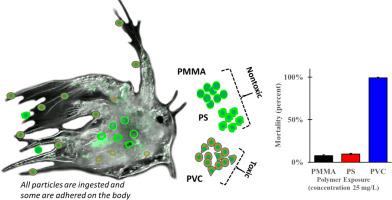Science of the Total Environment ( IF 8.2 ) Pub Date : 2021-10-15 , DOI: 10.1016/j.scitotenv.2021.150965 Yong Jie Yip 1 , Serina Siew Chen Lee 2 , Mei Lin Neo 2 , Serena Lay-Ming Teo 2 , Suresh Valiyaveettil 1

|
Pollution from plastic waste is increasingly prevalent in the environment and beginning to generate significant adverse impact on the health of living organisms. In this study, we investigate the toxicity of polymer nanoparticles exposed to Acorn Barnacle (Amphibalanus amphitrite) nauplii, as an animal model. Highly stable aqueous dispersion of luminescent nanoparticles from three common polymers: polymethylmethacrylate (PMMA), polystyrene (PS), and polyvinylchloride (PVC), were prepared via nanoprecipitation and fully characterised. Exposure studies of these polymer particles to freshly spawned barnacle nauplii were performed within a concentration range from 1 to 25 mg/L under laboratory-controlled conditions. The exposure to PMMA and PS nanoparticles did not show detrimental toxicity and did not cause sufficient mortality to compute a LC50 value. However, PVC nanoparticles were significantly toxic with a mortality rate of up to 99% at moderate concentrations of 25 mg/L, and the calculated LC50 value for PVC nanoparticles was 7.66 ± 0.03 mg/L, 95% CI. Interestingly, PVC nanoparticle aggregates were observed to adhere to the naupliar outer carapace and appendages at higher concentrations and could not be easily removed by washings. To explore the possibility of chemical toxicity of polymer nanoparticles, analysis of the polymer powders which was used to prepare the nanoparticles was conducted. The presence of low molecular weight oligomers such as dimers, trimers and tetramers were observed in all polymer samples. The chemical nature and concentration of such compounds are likely responsible for the observed toxicity to the barnacle nauplii. Overall, our study shows that care should be exercised in generalising the findings of exposure studies performed using one type of plastic particles, as the use of different plastic particles may elicit different responses inside a living organism.
中文翻译:

三种聚合物纳米粒子对橡子藤壶(Amphibalanus amphitrite)的毒性比较研究
塑料废物污染在环境中越来越普遍,并开始对生物体的健康产生重大不利影响。在这项研究中,我们调查了聚合物纳米颗粒暴露于橡子藤壶(Amphibalanus amphitrite) 无节幼体,作为动物模型。来自三种常见聚合物的发光纳米粒子的高度稳定的水分散体:聚甲基丙烯酸甲酯 (PMMA)、聚苯乙烯 (PS) 和聚氯乙烯 (PVC),通过纳米沉淀制备并充分表征。在实验室控制条件下,在 1 至 25 毫克/升的浓度范围内对这些聚合物颗粒进行了暴露研究。暴露于 PMMA 和 PS 纳米粒子没有表现出有害的毒性,也没有导致足够的死亡率来计算 LC 50值。然而,PVC 纳米颗粒具有显着毒性,在 25 mg/L 的中等浓度下死亡率高达 99%,计算的 LC 50PVC 纳米粒子的值为 7.66 ± 0.03 mg/L,95% CI。有趣的是,观察到 PVC 纳米颗粒聚集体以较高的浓度粘附在无节幼体的外甲壳和附属物上,并且不容易通过洗涤去除。为了探索聚合物纳米颗粒的化学毒性的可能性,对用于制备纳米颗粒的聚合物粉末进行了分析。在所有聚合物样品中都观察到低分子量低聚物如二聚体、三聚体和四聚体的存在。这些化合物的化学性质和浓度可能是观察到的藤壶无节幼体毒性的原因。总体而言,我们的研究表明,在概括使用一种塑料颗粒进行的暴露研究结果时应谨慎行事,









































 京公网安备 11010802027423号
京公网安备 11010802027423号